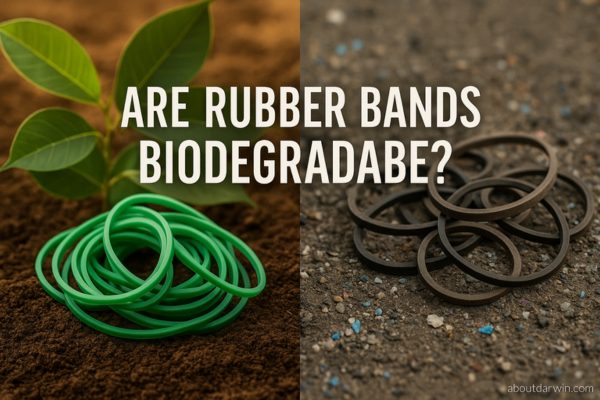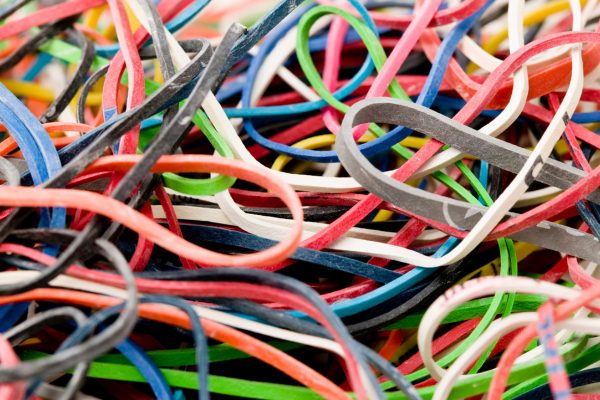

You’ve probably never given much thought to that drawer full of rubber bands in your kitchen. But here’s a surprising fact: those seemingly harmless elastic loops might be contributing to a much larger environmental problem than you realize.
The quick answer: Natural rubber bands ARE biodegradable and will decompose in 10-20 years, while synthetic rubber bands are NOT biodegradable and can persist in the environment for 50-300 years. This distinction is crucial because approximately 13,000 tons of rubber bands are sold globally each year.
Why does this matter? Most people assume all rubber bands decompose quickly, but with 70% of rubber production being synthetic, millions of these elastic bands end up polluting our landfills and oceans annually. The environmental implications are staggering.
In this comprehensive guide, we’ll explore the science behind rubber band biodegradability, their environmental impact, proper disposal methods, and eco-friendly alternatives that can help you make more sustainable choices.
Understanding whether rubber bands are biodegradable starts with knowing what they’re made from. Not all rubber bands are created equal, and their composition directly affects their environmental impact.
Natural rubber bands come from the latex sap of rubber trees (Hevea brasiliensis), primarily grown in Southeast Asia. The harvesting process, called “tapping,” involves making careful cuts in the tree bark to collect the milky latex without harming the tree.
This sustainable harvesting method allows rubber trees to produce latex for approximately 25 years. The trees reach maturity at 6 years old and continue providing this renewable resource throughout their productive life. After retirement, these trees are repurposed for furniture and timber products.
The composition of natural rubber elastics is remarkably simple: pure latex polymer with minimal additives. During manufacturing, the latex undergoes vulcanization with sulfur to improve elasticity and durability. This process creates the stretchy, resilient bands we use daily.
Synthetic rubber bands tell a different story. Made from petroleum-based chemicals through complex industrial processes, these bands dominate the market, accounting for 70% of global rubber production. The primary reason? They’re cheaper to produce and offer consistent quality.
The manufacturing process involves combining various petrochemicals to create polymers that mimic natural rubber’s properties. Common synthetic rubbers include styrene-butadiene rubber (SBR) and polyisoprene. These materials undergo extensive chemical processing with multiple additives.
Unlike their natural counterparts, synthetic bands contain numerous chemical compounds that resist biological breakdown. This petroleum dependency not only depletes fossil fuel resources but creates products that persist in the environment for centuries.
The biodegradability of rubber bands depends entirely on their material composition. This section explores the scientific processes that determine whether your rubber bands will return to the earth or remain as persistent pollutants.

Natural rubber bands are indeed biodegradable, but the process is slower than many people expect. Under optimal conditions, natural rubber decomposition takes 10-20 years. This timeline might seem long, but it’s significantly better than synthetic alternatives.
The breakdown process relies on specific microorganisms that can digest natural rubber polymers. Research has identified bacteria like Rhizobacter gummiphilus NS21 and Lactobacillus plantarum as effective rubber degraders. These microbes secrete enzymes that break down the polymer chains into smaller, digestible components.
Several factors affect rubber band decomposition time:
Synthetic rubber bands present a completely different challenge. Their complex chemical structure, designed for durability, becomes an environmental liability. These petroleum-based products can persist for 50-300 years without significant breakdown.
The molecular bonds in synthetic rubber resist natural decomposition processes. Unlike natural polymers, synthetic rubbers lack the specific sites where enzymes can attach and begin breakdown. Instead of biodegrading, they slowly fragment into smaller pieces through physical weathering.
This fragmentation creates microplastics that contaminate soil and water systems. These tiny particles can be ingested by wildlife and enter the food chain, potentially affecting human health. The persistence of synthetic bands makes them a long-term pollution source.
Understanding decomposition timelines helps illustrate why material choice matters for environmental sustainability. The contrast between natural and synthetic rubber bands is stark.
| Material Type | Decomposition Time | Environmental Conditions | Final Products |
|---|---|---|---|
| Natural Rubber | 10-20 years | Soil, compost, or landfill | CO2, water, biomass |
| Synthetic Rubber | 50-300 years | Any environment | Microplastics, chemical residues |
| Natural (in compost) | 6-24 months | Active compost pile | Nutrient-rich humus |
| Synthetic (in ocean) | Centuries | Marine environment | Persistent microplastics |
Environmental factors dramatically influence these timelines. In a hot, humid compost pile with active microorganisms, natural rubber bands can break down in as little as 6 months. However, in dry landfill conditions with limited oxygen, the same band might take two decades.
Real-world scenarios often involve less-than-ideal conditions. A rubber band dropped in a park might experience UV degradation from sunlight, physical weathering from rain, and microbial action from soil contact. Natural bands eventually disappear, while synthetic ones merely break into smaller pieces.
The environmental footprint of rubber bands extends far beyond their small size. From production emissions to disposal challenges, these everyday items contribute to several ecological problems.
The scale of rubber band production reveals their significant environmental impact. With 13,000 tons produced annually, the manufacturing process alone generates substantial carbon emissions. Studies indicate that rubber band production emits 1.16-1.53 tons of CO2 per ton of product.
The U.S. Post Office stands as the largest single consumer, using millions of bands annually for mail sorting. This institutional use, combined with household and business consumption, creates a massive waste stream. Most bands end up in landfills where they occupy space for decades or centuries.
Energy consumption during manufacturing adds another layer of concern. Synthetic rubber production requires intensive petroleum processing, while even natural rubber involves transportation from tropical regions to manufacturing facilities worldwide. This global supply chain increases the carbon footprint significantly.
Beyond production impacts, discarded rubber bands pose direct threats to ecosystems. Wildlife often mistakes colorful bands for food, leading to ingestion that can cause intestinal blockages or death. Birds, sea turtles, and small mammals are particularly vulnerable.
Marine environments suffer when rubber bands enter waterways. These items can entangle marine life, restricting movement and growth. Fish and seabirds may consume band fragments, introducing toxins into the food chain. The bands also contribute to the growing problem of ocean plastic pollution.
Soil contamination represents another concern, especially with synthetic bands. As they slowly break down, they release chemical additives into the ground. These substances can affect soil pH, harm beneficial microorganisms, and potentially enter groundwater systems. The long-term effects on soil health remain a growing environmental concern.
Composting offers a potential solution for rubber band disposal, but success depends entirely on the band’s composition. Understanding proper composting techniques can help divert these items from landfills.
Natural rubber bands can successfully join your compost pile, though they require specific handling for optimal breakdown. The key is creating conditions that support the microorganisms responsible for rubber decomposition.
Step-by-Step Composting Guide:
For best results, bury rubber band pieces deep within the pile where moisture and heat concentrate. Expect decomposition within 6-24 months depending on your composting system’s efficiency. The bands will eventually contribute to nutrient-rich compost.
Synthetic rubber bands have no place in compost bins. Their petroleum-based composition resists biological breakdown and can contaminate your entire compost batch. These materials simply don’t decompose through composting processes.
Adding synthetic bands to compost creates several problems. They can leach chemicals into the developing compost, potentially harming plants when the compost is used. The bands also disrupt the visual quality of finished compost, requiring manual removal.
If you’re unsure about your rubber bands’ composition, err on the side of caution. The risk of contaminating months of composting effort isn’t worth the attempt. Save composting for confirmed natural rubber products only.
Recycling rubber bands presents unique challenges that most municipal programs can’t accommodate. Understanding these limitations helps explain why alternative disposal methods are necessary.
Traditional recycling facilities lack the specialized equipment needed to process rubber bands effectively. The elastic nature of bands can jam sorting machinery, while their small size allows them to fall through screening systems. Most recycling programs explicitly exclude rubber bands.
The mixed composition of many rubber bands further complicates recycling. Bands often contain various additives, dyes, and treatments that make material separation difficult. Even facilities that accept rubber products typically require large volumes of uniform material.
Some specialized programs accept rubber for downcycling into playground surfaces or athletic tracks. However, these programs usually focus on tires and industrial rubber waste rather than small consumer items. For practical purposes, rubber bands remain non-recyclable in most areas.
Choosing sustainable alternatives reduces environmental impact while maintaining functionality. Modern options range from biodegradable bands to completely different fastening solutions.
| Alternative | Durability | Cost | Biodegradable | Reusable | Best Use |
|---|---|---|---|---|---|
| Natural Rubber Bands | Moderate | Low | Yes (10-20 years) | Limited | General purpose |
| Silicone Bands | Very High | High | No | Yes | Heat/cold applications |
| Hemp Cord | Moderate | Low | Yes (months) | No | Packaging, bundling |
| Fabric Strips | Low | Free | Yes (months) | Yes | Light bundling |
| Metal Clips | Very High | Moderate | No | Yes | Office use |
| Biodegradable Bands | Moderate | Moderate | Yes (1-2 years) | Limited | Eco-conscious users |
Several companies now produce certified biodegradable elastic bands using innovative materials. These products combine functionality with environmental responsibility, decomposing within 1-2 years under proper conditions.
Natural rubber bands from sustainable plantations represent the most accessible biodegradable option. Look for products certified by environmental organizations that verify sustainable harvesting practices. These bands perform identically to conventional options while supporting responsible forestry.
Some manufacturers create bands from alternative materials like organic cotton elastic or plant-based polymers. While these may cost more, they offer superior biodegradability and often come in plastic-free packaging. The investment supports continued innovation in sustainable products.
Silicone bands excel where durability matters most. These heat-resistant, washable options can last years with proper care. While not biodegradable, their longevity reduces overall consumption. They’re ideal for kitchen use or outdoor applications.
Fabric alternatives like cloth strips or ribbon provide biodegradable solutions from existing materials. Old clothing can be cut into strips for bundling items. These free alternatives decompose naturally while giving textiles a second life.
For office or industrial use, metal clips and reusable cable ties offer permanent solutions. Though initially more expensive, these items eliminate ongoing rubber band purchases. Their durability makes them cost-effective for frequently bundled items.
Distinguishing between rubber band types empowers better purchasing decisions. Several methods help identify band composition without specialized equipment.

Visual and Tactile Differences:
The burn test provides definitive identification but requires safety precautions. Natural rubber burns with a smoky flame and leaves ash, while synthetic rubber melts and drips, producing black smoke with a chemical odor. Always perform this test outdoors with proper ventilation.
Label reading becomes easier with practice. Look for terms like “natural latex,” “pure rubber,” or “biodegradable.” Synthetic products often list “synthetic rubber,” “SBR,” or include no material information. Trusted eco-friendly brands clearly label their natural rubber products.
Implementing sustainable practices with rubber bands reduces environmental impact while maintaining their utility. Small changes in habits create meaningful differences.
Proper storage significantly extends rubber band usability. Keep bands in a cool, dry place away from direct sunlight. UV exposure degrades both natural and synthetic rubber, causing brittleness. An airtight container prevents oxidation.
Create a rubber band station where used bands accumulate for reuse. Wash bands periodically with mild soap to remove dirt and oils that accelerate degradation. Sort by size for easy selection, encouraging reuse over disposal.
Consider band strength for each application. Using appropriately sized bands prevents breakage and waste. Doubling thin bands instead of using one thick band provides flexibility while maximizing the lifespan of your rubber band collection.
When disposal becomes necessary, proper handling minimizes environmental harm. Always cut rubber bands before disposal to prevent wildlife entanglement. A simple snip transforms a potential trap into a harmless piece of waste.
Separate natural and synthetic bands when possible. Natural bands can join compostable materials, while synthetic ones belong in general waste. This segregation supports proper waste processing and reduces contamination.
Check for local specialty recycling programs that accept rubber products. Some communities organize periodic collections for hard-to-recycle items. TerraCycle and similar organizations offer mail-in programs for various rubber products, though fees may apply.
Natural rubber is biodegradable, breaking down through microbial action over 10-20 years. The biodegradation process depends on environmental conditions like temperature, moisture, and oxygen availability. Synthetic rubber, however, is not biodegradable and persists in the environment for centuries.
Pure natural rubber bands don’t contain plastic, but synthetic rubber bands are essentially plastic products made from petroleum-based polymers. Many modern rubber bands blend natural and synthetic materials, so they may contain some plastic components. Always check product labels for composition details.
Only natural rubber bands are compostable, and they represent about 30% of the market. The majority of rubber bands contain synthetic materials that won’t break down in compost. When in doubt, keep rubber bands out of your compost to avoid contamination.
Natural rubber bands can technically be incorporated into garden mulch, but it’s not recommended. They decompose too slowly to provide immediate benefits and may create an unsightly appearance. Better mulch alternatives include wood chips, leaves, or straw that break down more predictably.
In marine environments, natural rubber bands slowly biodegrade while releasing particles that marine life might ingest. Synthetic bands persist indefinitely, breaking into microplastics that enter the food chain. Both types can entangle marine animals, causing injury or death before decomposition occurs.
The biodegradability of rubber bands isn’t a simple yes-or-no answer. Natural rubber bands will eventually return to the earth, taking 10-20 years to decompose, while synthetic bands persist as environmental pollutants for 50-300 years or more. This distinction matters immensely given the 13,000 tons produced annually.
Understanding your rubber bands’ composition empowers better choices. Choose natural rubber when bands are necessary, but consider reusable alternatives like silicone bands or fabric ties for long-term solutions. When disposal is unavoidable, cut bands to prevent wildlife harm and compost only confirmed natural rubber products.
The future of sustainable elastic solutions lies in conscious consumption and innovative alternatives. By making informed choices today, we can reduce the environmental impact of these ubiquitous items. Every small action, from reusing a single rubber band to choosing biodegradable options, contributes to a healthier planet for future generations.
